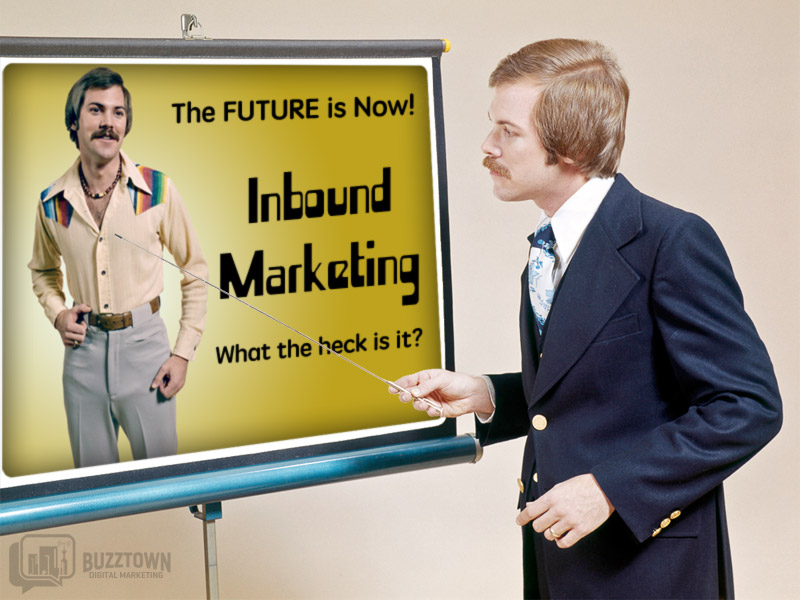
So, what the heck is Inbound marketing? Well, you can divide marketing into two groups, inbound marketing and, you guessed it, outbound marketing. There is a huge difference between the two including cost, efficiency, and how the potential customer feels towards your company after encountering a piece of your marketing efforts. To understand what it is, we should first take a look at what it isn’t. Let’s start with outbound marketing.
What is Outbound Marketing?
Also known by some as interruption marketing, Outbound Marketing uses traditional marketing methods that force the consumer to suspend what they were doing to interact with your piece of marketing. Examples of outbound marketing are outdoor billboards (interrupting someone’s attention while driving), a television commercial (interrupting the program that the viewer was watching), magazine ads (interrupting the article being read), cold calls from telemarketers (usually, it seems, interrupting dinner), and spam email. These types of advertising and marketing have always had very, very low return. How many times have you been reading a magazine, recognize that the next page is an ad, then turn the page before you looked at the logo or even what the product was that they were selling? This especially happens in those magazines that you “read just for the articles” and completely “ignore” the centerfold, am I right? Well, most people do. It’s becoming easier to ignore outbound marketing methods like TV ads (thanks DVR!), cold calls (thanks National Do Not Call list!) and Spam email (a BIG thank you to my spam filter for knowing that I don’t need any Canadian medication of the enlarging type!). Companies spend a ton of money on billboards, TV ads, radio ads, magazine ads, and other forms of Outbound Marketing, but it is hard to know which method really works best, and to get an accurate measurement on which is driving the most business.
Ok, so what is Inbound Marketing
Wait, did you hear that? It sounded almost like angels singing? Oh, wait, that’s just marketers everywhere singing about inbound marketing. Inbound Marketing is a series of strategies that focus on attracting customers through posting original content that is easily shareable and answers the questions that the customer was searching for. This is typically done through blog posts, ebooks, infographics, and videos. As the customer progresses down the sales funnel, other Inbound techniques, such as personalized emails, are used to persuade the customer to complete the sale. The customers are then kept and (hopefully) grow loyal to the brand through more original content, and attracting them back the same methods that they initially encountered. Inbound marketing bring customers “in” as opposed to marketers having to go “out” to wave down a few customers by stealing their attention away. The methods used by Inbound Marketers include content marketing (informative blog posts, videos, ebooks, infographics, etc), social media marketing, SEO, email marketing (not spam, but useful emails that customers actually sign up to receive) and even PPC or pay-per-click ads (those ads that you see on the right side of Google searches).
These methods, when used together, can garner a lot of attention from your pool of potential customers. Let’s look at an example of how Inbound Marketing can work. So, let’s say that I own a small independent toy store (the 6 year old in me just squealed with delight at the thought). Starting with my website, there are numerous things to do to make sure that my SEO is up to snuff. With so many things that I can do to make sure that the “Search Gods” look favorably on my website through SEO, I’ll leave that part for another post (here, I’m focusing on general Inbound Marketing). But, just know that SEO is incredibly important so that you are found easily when your customers are searching for you. I would also start an email newsletter that is sent out weekly with deals, coupons, and links to product video reviews. Watching kids review a new toy can be fascinating, funny, and informative. It could prove to be a popular feature that customers look forward to watching. These videos would be included in blog posts that mirror what the kids in the videos are saying. Of course, the videos and blog posts would be shared via social media. The videos would do well on Facebook using Facebook’s native video player. Twitter would be used more often for the videos, blog posts, and posting pictures of Star Wars figures in funny situations. Instagram is a great social network for the Star Wars figures series as well. I would also target potential customers that live near my store with ads on Google and parents that are near me on Facebook. All of these techniques can be measured and analyzed to see what works and what doesn’t so that changes can be made.
Ok, so that’s Inbound Marketing. Now, there is a bit more involved than my quick example above, but it gives you an idea of what can be done. What other Inbound Marketing techniques would you instate to help my fictional toy store succeed? Please let me know in the comments below. If you have any questions about Inbound Marketing, let us know!
Langdon Siggelkow (rhymes with Giggle Show) is the Founder and Mayor of BuzzTown. A website designer and developer since 1996, Langdon has no problem typing this in the third person so that it seems like someone else is saying great things about him. He was a working Stand Up Comedian for several years and wants to add humor to discussions on creative inbound marketing strategies. Langdon has spoken at several events about using Social Media, Inbound Marketing, and creative ways to be memorable. Connect with Langdon on LinkedIn
What the Buzz?
We are a digital marketing company with a focus on helping our customers achieve great results and tell great stories.
Request a free quote
We offer a full range of Digital Marketing services, from SEO and website design to content marketing and email marketing, that tell the story of your business and make sure that your current and future customers experience can find you when they need you most.




